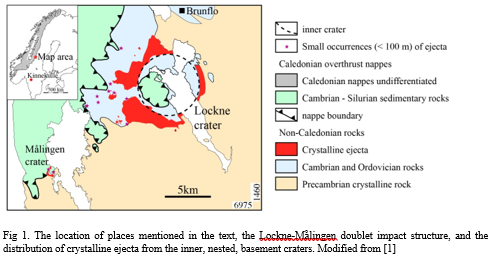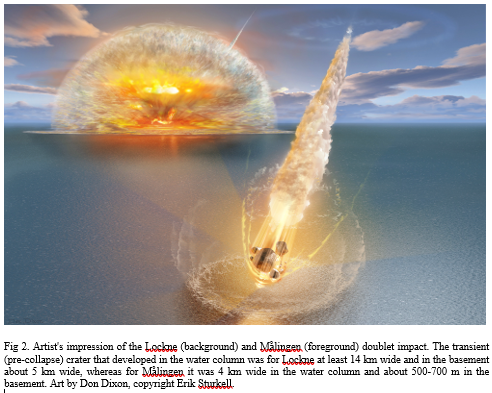The Lockne – Målingen doublet: effects of a rubble-pile impact in a marine environment (layered target)
- 1Earth Sciences Centre, Univ. of Gothenburg, Sweden
- 2Centro de Astrobiologia (INTA-CSIC), Dept Planetology and Habitability, Torrejon de Ardoz, Spain (ormoj@cab.inta-csic.es)
The Lockne Crater and its smaller companion Målingen form the yet only confirmed impact structure from a binary, most likely of “rubble-pile” configuration, asteroid on Earth [1]. Both craters formed simultaneously in a shallow sea that allowed them to become very well preserved with most of the crater filling and near-field ejecta remaining. This provides a unique opportunity to explore the crater morphology as it was directly after the cratering and early modification. The marine target setting with seawater and sedimentary strata covering a flat and near-horizontal crystalline peneplain can be seen as an extreme case of target layers of different density and strength, which is known to impose a certain concentric shape of the resulting crater. We are investigating how the concentricity may be enhanced by the oblique, rubble-pile (pancake-shape after atmospheric entry) impact.
Introduction
At Lockne, the inner, nested, crater of about 7.5 km width is surrounded by a shallow, approximately 14 km wide, outer crater visible in the sedimentary rock. The oblique impact caused a downrange offset of the outer crater [2]. At Målingen, the nested crater in the basement is only about 0.7 km wide (Fig. 1).

Both craters formed simultaneously (Fig. 2) by the impact of a binary asteroid at 458 Ma [1,3]. The Lockne/Målingen asteroid was generated in a massive collision in the asteroid belt at ~470 Ma, the so-called Middle Ordovician breakup event [4,5]. Not all fragments from a break-up event are massive and monolithic. After a catastrophic breakup of asteroids, smaller fragments can re-accumulate relatively fast (order of weeks) by gravitational attraction into larger objects, so-called “rubble-piles”. It is known that if an asteroid is binary, like in the case for Lockne-Målingen, it is a good indication that it is a rubble-pile.

Geologically constrained, advanced 3-D numerical simulations of the Lockne impact have so far been done for a monolithic impactor [e.g., 6]. A best fit between the crater dimensions and the projectile for an impact of the most common configuration, i.e. 45° impact angle in an East to West direction, and 15 km/s impact velocity, gave a projectile size of about 600 m in diameter and a target water depth of slightly less than the projectile diameter. Likewise, based on numerical simulation of small marine target impacts [7], Ormö et al. [3] estimated the Målingen projectile to have been about 150 m in diameter if assumed a massive body. However, a rubble-pile asteroid of the dimensions of the Lockne and Målingen projectiles will separate upon entry into the atmosphere, but maintain their trajectory causing a “pancake-like” cluster, or debris-jet of projectiles [8]. The effect on the target area can, much simplified, be compared to that of a shotgun blast rather than a single rifle bullet, i.e. a shallow, widespread, but still coherent crater. The effect is enhanced in targets with weaker material covering a more massive substrate, as porous, wide projectiles tend to release their energy nearer to the target surface, i.e., in the here also more easily excavated upper layer. The diameter of the pancake-shaped cluster may exceed that of the initial projectile body by an order of magnitude [8]. Obliquity of impact is intensifying the breakup effect, the near-surface release of energy, and also the downrange extent and offset of the shallow outer crater [2].
Ongoing and planned activities
Our geological investigations of the Lockne- Målingen doublet crater serve as basis for numerical simulations [9], but also experiments to be carried out in the Experimental Projectile Impact Chamber (EPIC) at the Centro de Astrobiología in Spain. The simulations will increase our understanding of the subsurface morphology of the otherwise well-documented craters, e.g., the shape of true crater floor, the existence of a central uplift, and dimensions of the damaged zone around the crater. The experiments will focus on:
a) The influence of a layered target on both vertical and oblique impacts. Some initial studies have already been successfully performed [2,10]. The experiments are carried out as projectile shots into granular targets with layers of different properties.
b) The effects of a clustered projectile (”rubble-pile”) vs. a massive projectile of the same material and mass. The special design of the EPIC cannon allows the use of a great variety of projectiles. The shots will be made into single and dual layer granular targets.
c) A repetition of the shots in points ”a” and ”b” above, but in aquatic targets with various water layer thicknesses.
The definition of the deep subsurface morphology of especially the Lockne crater, combined with its already exceptionally well-known surface geology, will add the Lockne-Målingen doublet to the best-studied craters in the world as well as provide a unique opportunity for the analysis (geological and/or numerical) of the effects of an impact from a binary, “rubble-pile” asteroid into a layered target.
How to cite: Sturkell, E. and Ormö, J.: The Lockne – Målingen doublet: effects of a rubble-pile impact in a marine environment (layered target), Europlanet Science Congress 2020, online, 21 September–9 Oct 2020, EPSC2020-956, https://doi.org/10.5194/epsc2020-956, 2020

